Chemical constituents from the leaves of Styrax annamensis Guill
A phytochemical study of the ethyl acetate extract (EtOAc) of Styrax annamensis leaves resulted in the isolation
and determination of six known compounds, including three nor-neolignans type 2-phenylbenzofurans egonol (1),
egonoic acid (2) and (–)-machicendiol (3), two lignans styraxin (4) and vladinol D (5), and a triterpenoid pomolic acid
(6). The chemical structures of these compounds were determined by NMR spectroscopies, and MS data. This is the
first time to isolate these compounds from S. annamensis species. Compounds 3 and 5 have also been observed from
genus Styrax for the first time.
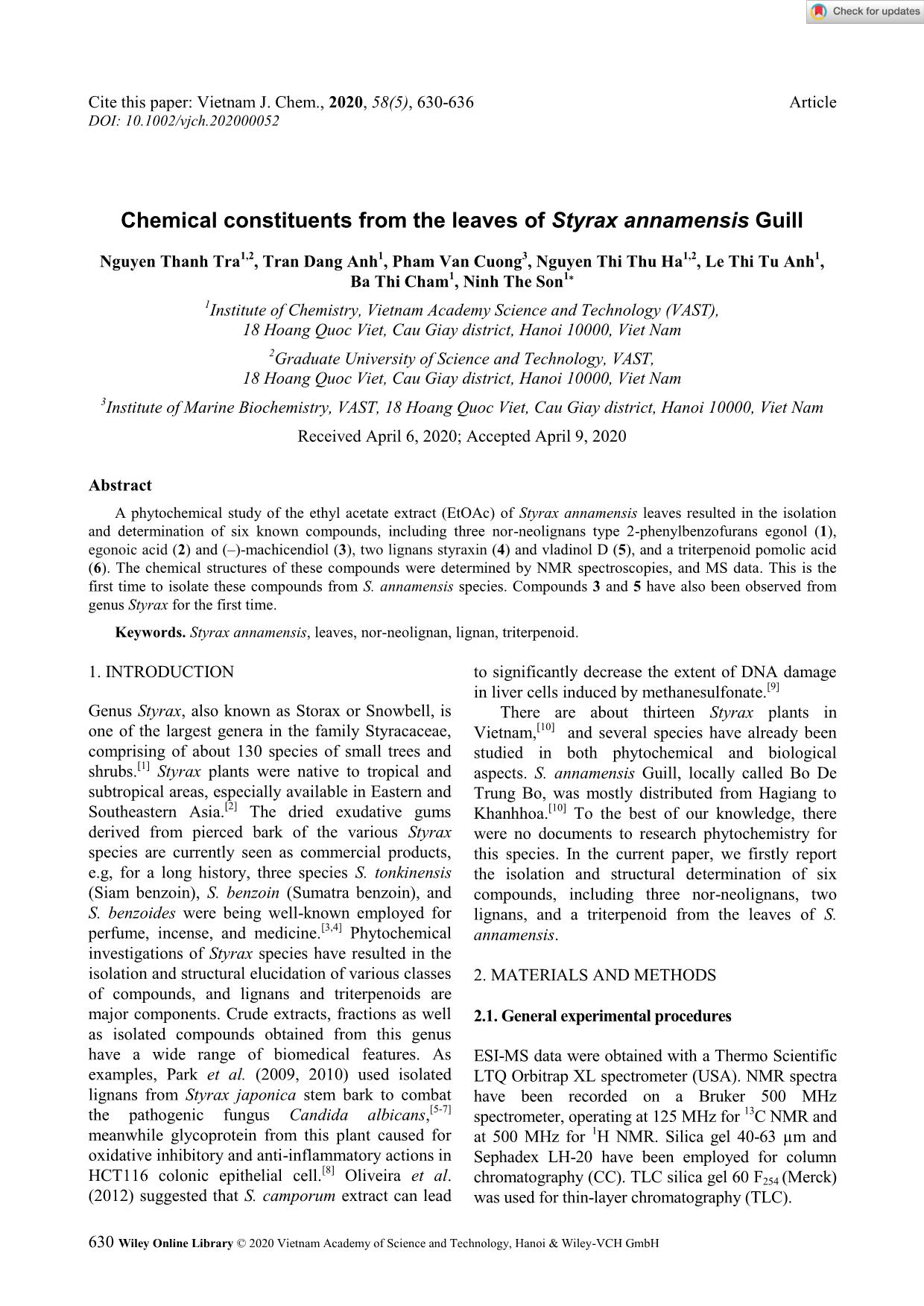
Trang 1
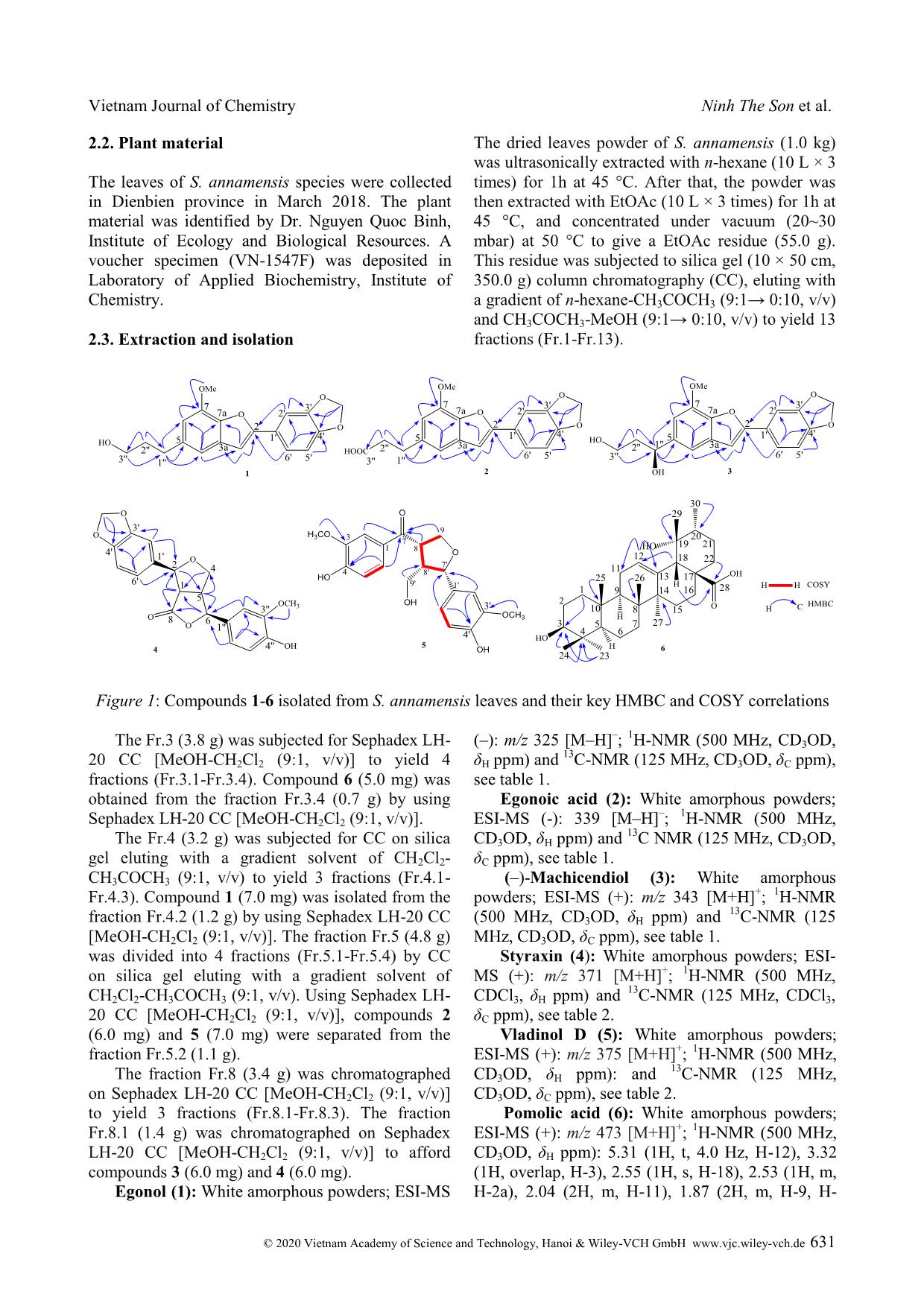
Trang 2
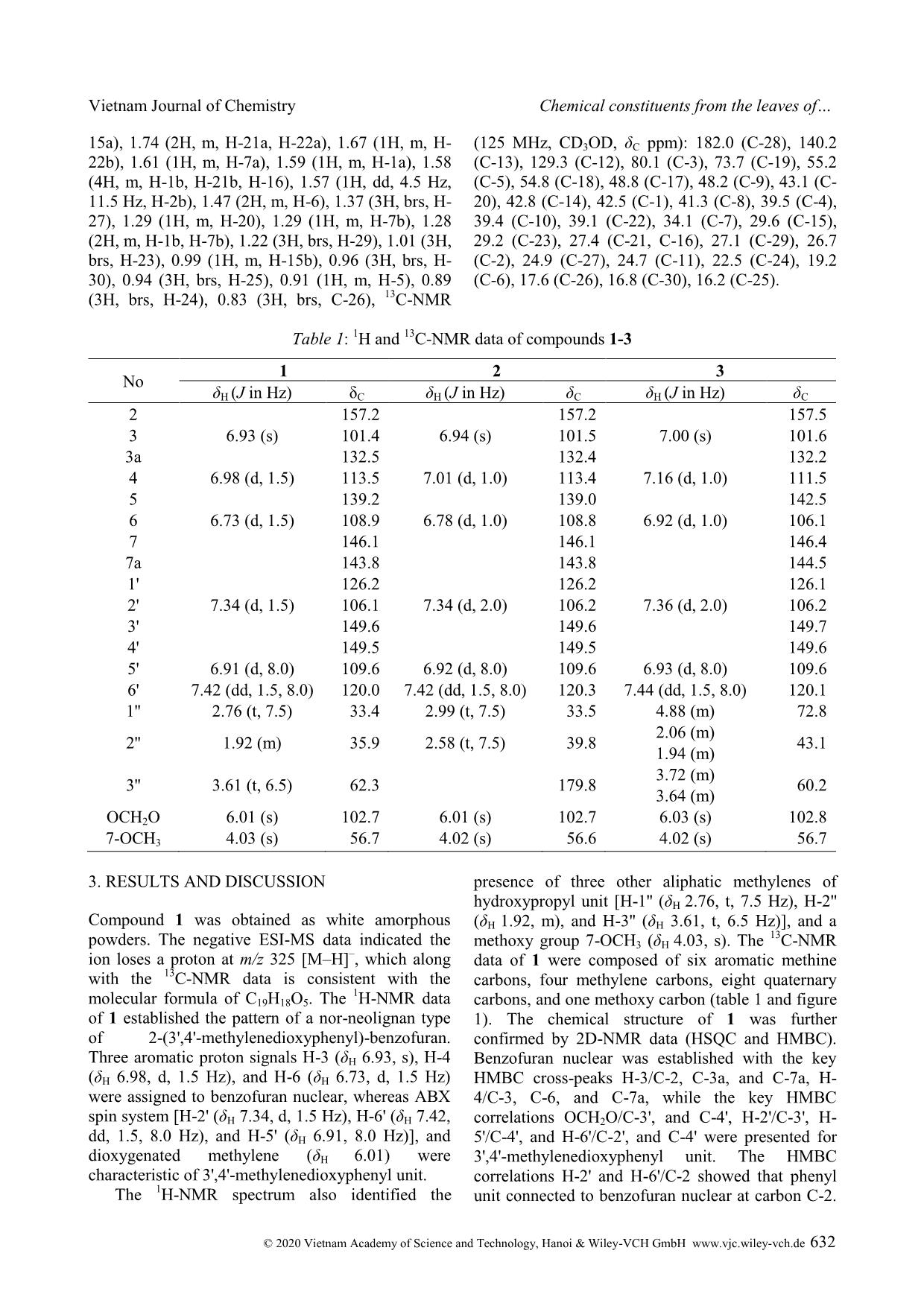
Trang 3
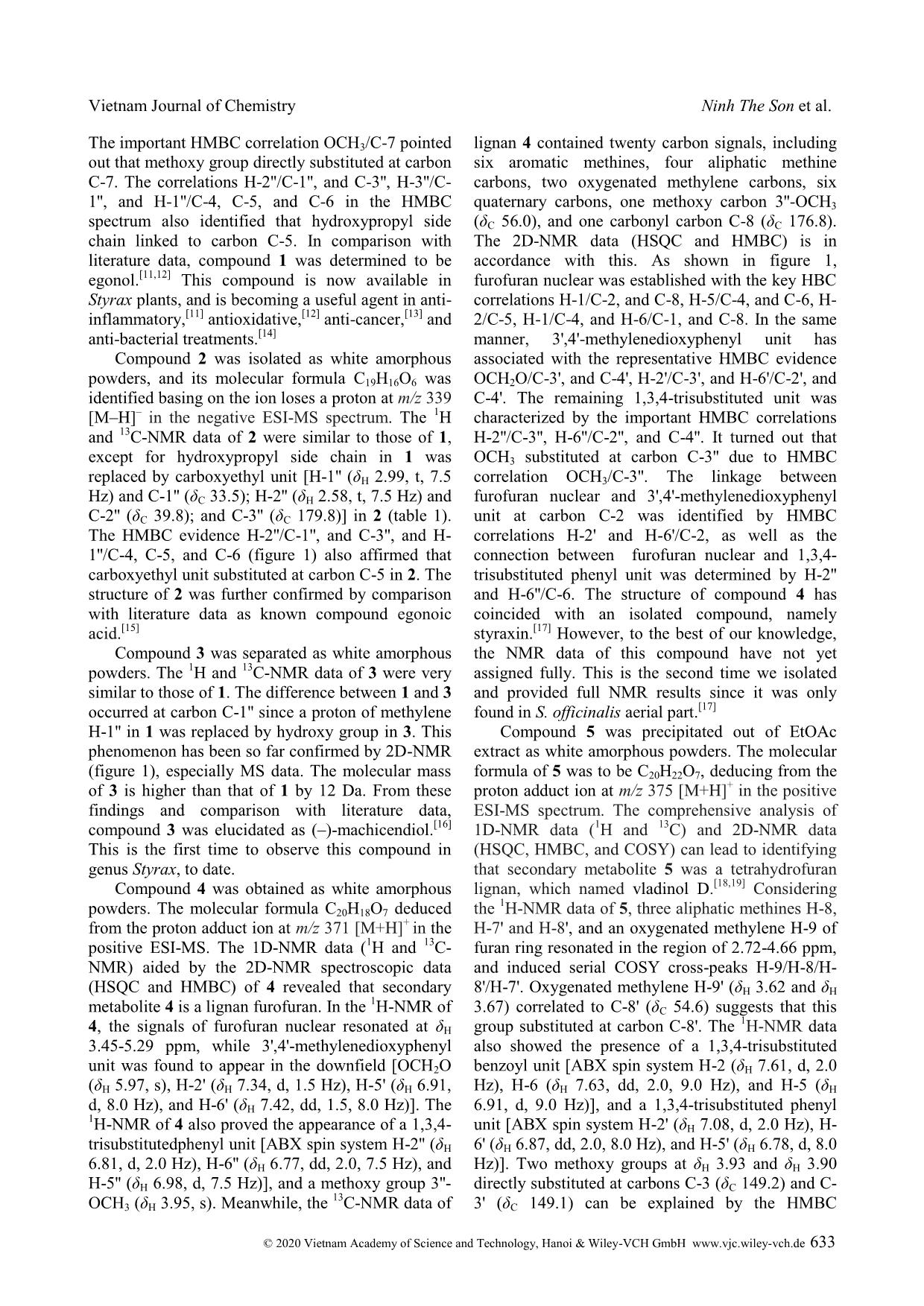
Trang 4
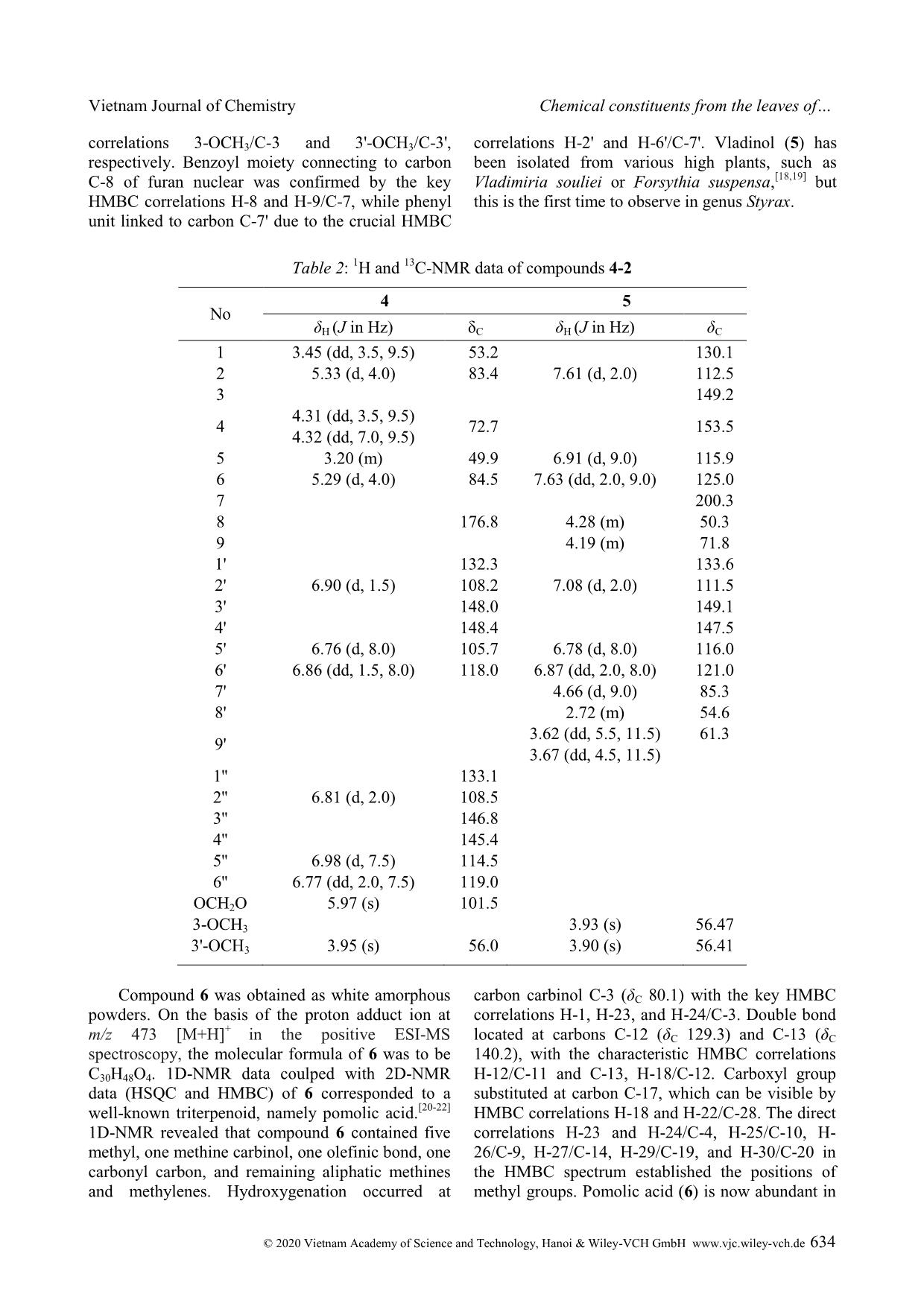
Trang 5
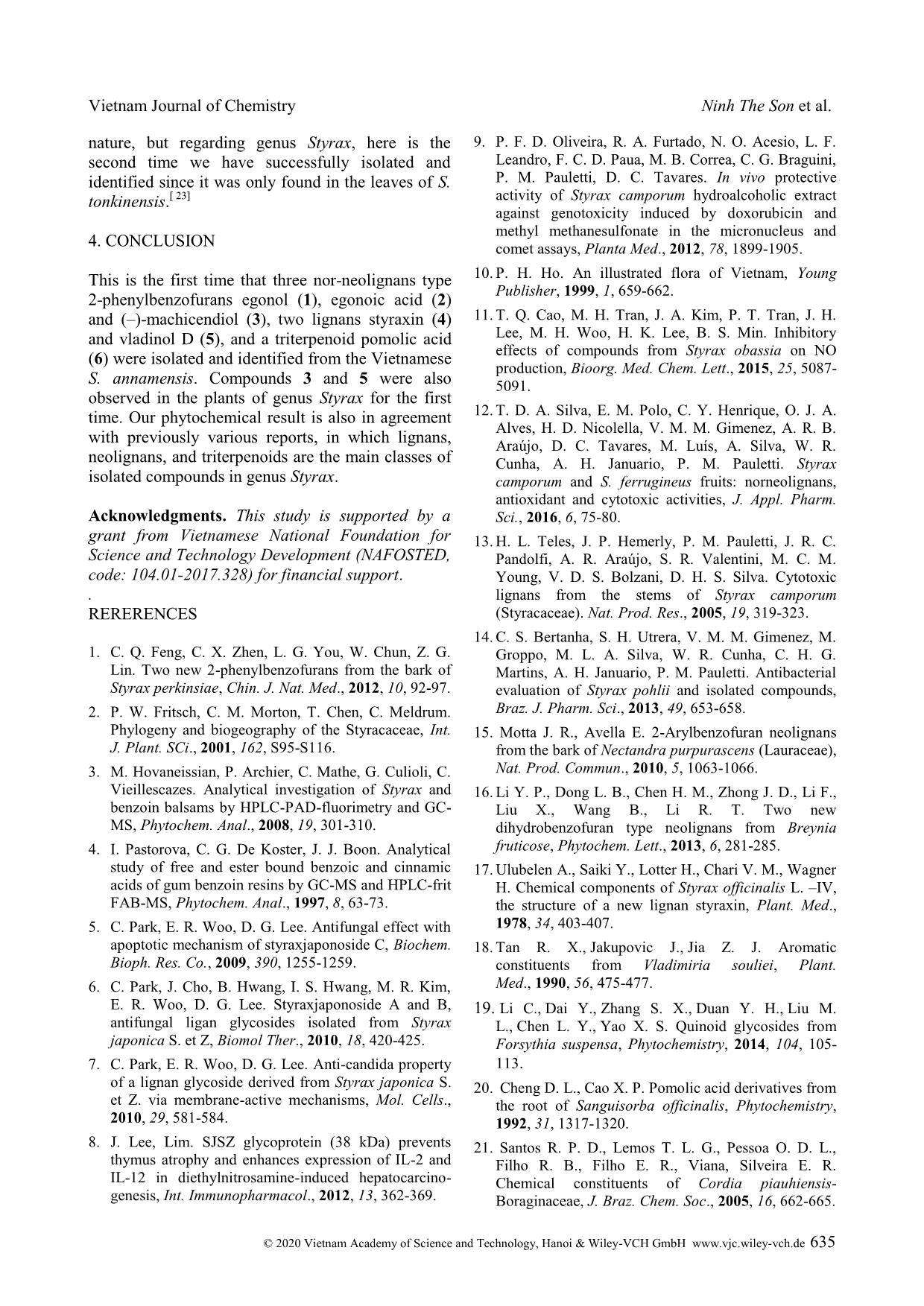
Trang 6
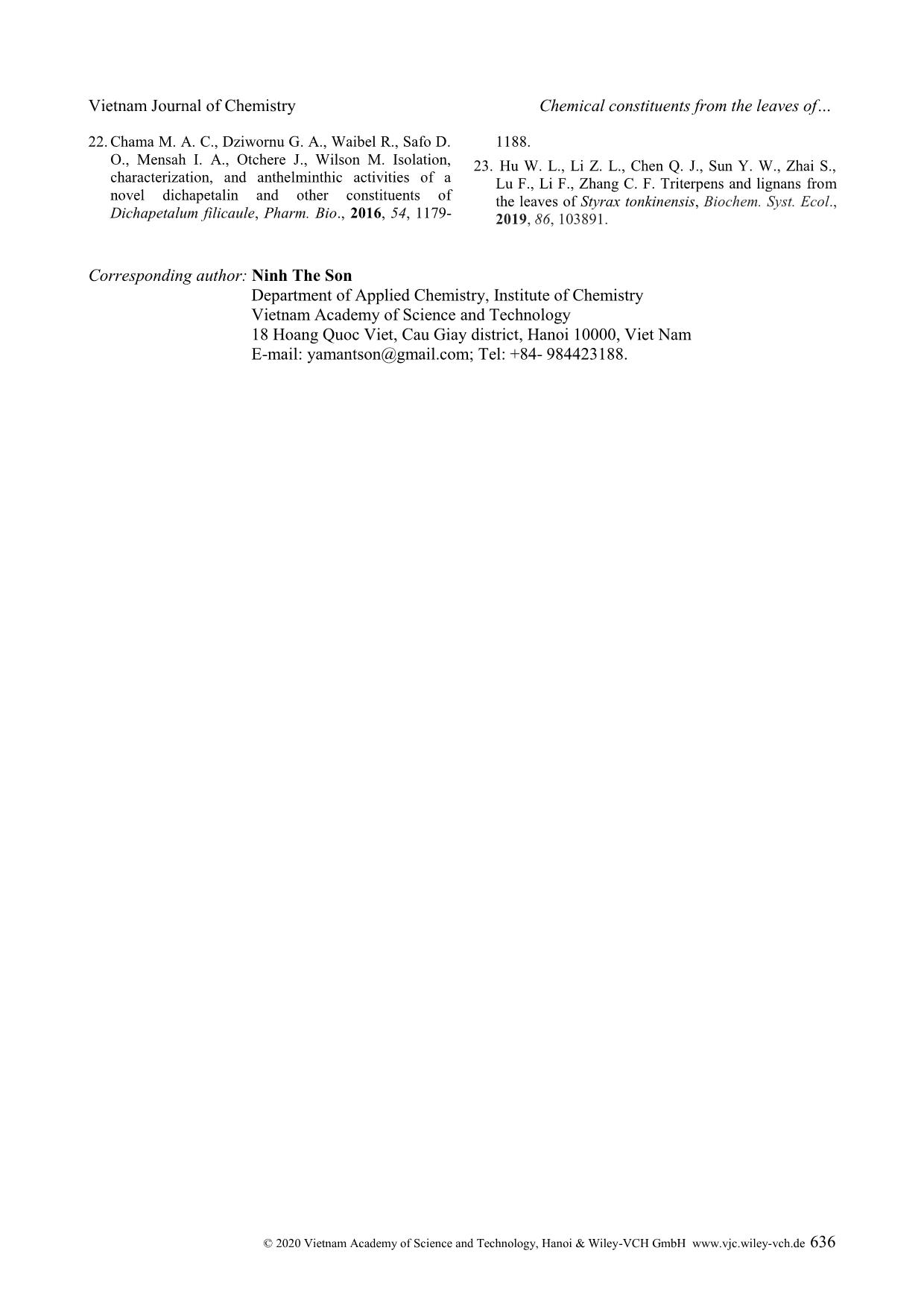
Trang 7
Bạn đang xem tài liệu "Chemical constituents from the leaves of Styrax annamensis Guill", để tải tài liệu gốc về máy hãy click vào nút Download ở trên
Tóm tắt nội dung tài liệu: Chemical constituents from the leaves of Styrax annamensis Guill
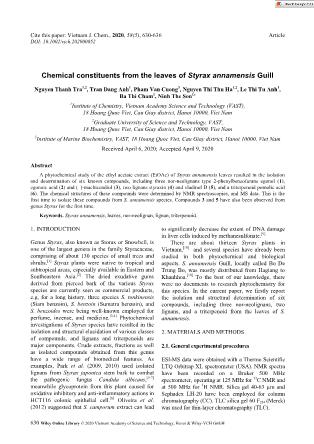
Cite this paper: Vietnam J. Chem., 2020, 58(5), 630-636 Article DOI: 10.1002/vjch.202000052 630 Wiley Online Library © 2020 Vietnam Academy of Science and Technology, Hanoi & Wiley-VCH GmbH Chemical constituents from the leaves of Styrax annamensis Guill Nguyen Thanh Tra 1,2 , Tran Dang Anh 1 , Pham Van Cuong 3 , Nguyen Thi Thu Ha 1,2 , Le Thi Tu Anh 1 , Ba Thi Cham 1 , Ninh The Son 1* 1 Institute of Chemistry, Vietnam Academy Science and Technology (VAST), 18 Hoang Quoc Viet, Cau Giay district, Hanoi 10000, Viet Nam 2 Graduate University of Science and Technology, VAST, 18 Hoang Quoc Viet, Cau Giay district, Hanoi 10000, Viet Nam 3 Institute of Marine Biochemistry, VAST, 18 Hoang Quoc Viet, Cau Giay district, Hanoi 10000, Viet Nam Received April 6, 2020; Accepted April 9, 2020 Abstract A phytochemical study of the ethyl acetate extract (EtOAc) of Styrax annamensis leaves resulted in the isolation and determination of six known compounds, including three nor-neolignans type 2-phenylbenzofurans egonol (1), egonoic acid (2) and (–)-machicendiol (3), two lignans styraxin (4) and vladinol D (5), and a triterpenoid pomolic acid (6). The chemical structures of these compounds were determined by NMR spectroscopies, and MS data. This is the first time to isolate these compounds from S. annamensis species. Compounds 3 and 5 have also been observed from genus Styrax for the first time. Keywords. Styrax annamensis, leaves, nor-neolignan, lignan, triterpenoid. 1. INTRODUCTION Genus Styrax, also known as Storax or Snowbell, is one of the largest genera in the family Styracaceae, comprising of about 130 species of small trees and shrubs. [1] Styrax plants were native to tropical and subtropical areas, especially available in Eastern and Southeastern Asia. [2] The dried exudative gums derived from pierced bark of the various Styrax species are currently seen as commercial products, e.g, for a long history, three species S. tonkinensis (Siam benzoin), S. benzoin (Sumatra benzoin), and S. benzoides were being well-known employed for perfume, incense, and medicine. [3,4] Phytochemical investigations of Styrax species have resulted in the isolation and structural elucidation of various classes of compounds, and lignans and triterpenoids are major components. Crude extracts, fractions as well as isolated compounds obtained from this genus have a wide range of biomedical features. As examples, Park et al. (2009, 2010) used isolated lignans from Styrax japonica stem bark to combat the pathogenic fungus Candida albicans, [5-7] meanwhile glycoprotein from this plant caused for oxidative inhibitory and anti-inflammatory actions in HCT116 colonic epithelial cell. [8] Oliveira et al. (2012) suggested that S. camporum extract can lead to significantly decrease the extent of DNA damage in liver cells induced by methanesulfonate. [9] There are about thirteen Styrax plants in Vietnam, [10] and several species have already been studied in both phytochemical and biological aspects. S. annamensis Guill, locally called Bo De Trung Bo, was mostly distributed from Hagiang to Khanhhoa. [10] To the best of our knowledge, there were no documents to research phytochemistry for this species. In the current paper, we firstly report the isolation and structural determination of six compounds, including three nor-neolignans, two lignans, and a triterpenoid from the leaves of S. annamensis. 2. MATERIALS AND METHODS 2.1. General experimental procedures ESI-MS data were obtained with a Thermo Scientific LTQ Orbitrap XL spectrometer (USA). NMR spectra have been recorded on a Bruker 500 MHz spectrometer, operating at 125 MHz for 13 C NMR and at 500 MHz for 1 H NMR. Silica gel 40-63 µm and Sephadex LH-20 have been employed for column chromatography (CC). TLC silica gel 60 F254 (Merck) was used for thin-layer chromatography (TLC). Vietnam Journal of Chemistry Ninh The Son et al. © 2020 Vietnam Academy of Science and Technology, Hanoi & Wiley-VCH GmbH www.vjc.wiley-vch.de 631 2.2. Plant material The leaves of S. annamensis species were collected in Dienbien province in March 2018. The plant material was identified by Dr. Nguyen Quoc Binh, Institute of Ecology and Biological Resources. A voucher specimen (VN-1547F) was deposited in Laboratory of Applied Biochemistry, Institute of Chemistry. 2.3. Extraction and isolation The dried leaves powder of S. annamensis (1.0 kg) was ultrasonically extracted with n-hexane (10 L × 3 times) for 1h at 45 °C. After that, the powder was then extracted with EtOAc (10 L × 3 times) for 1h at 45 °C, and concentrated under vacuum (20~30 mbar) at 50 °C to give a EtOAc residue (55.0 g). This residue was subjected to silica gel (10 × 50 cm, 350.0 g) column chromatography (CC), eluting with a gradient of n-hexane-CH3COCH3 (9:1→ 0:10, v/v) and CH3COCH3-MeOH (9:1→ 0:10, v/v) to yield 13 fractions (Fr.1-Fr.13). Figure 1: Compounds 1-6 isolated from S. annamensis leaves and their key HMBC and COSY correlations The Fr.3 (3.8 g) was subjected for Sephadex LH- 20 CC [MeOH-CH2Cl2 (9:1, v/v)] to yield 4 fractions (Fr.3.1-Fr.3.4). Compound 6 (5.0 mg) was obtained from the fraction Fr.3.4 (0.7 g) by using Sephadex LH-20 CC [MeOH-CH2Cl2 (9:1, v/v)]. The Fr.4 (3.2 g) was subjected for CC on silica gel eluting with a gradient solvent of CH2Cl2- CH3COCH3 (9:1, v/v) to yield 3 fractions (Fr.4.1- Fr.4.3). Compound 1 (7.0 mg) was isolated from the fraction Fr.4.2 (1.2 g) by using Sephadex LH-20 CC [MeOH-CH2Cl2 (9:1, v/v)]. The fraction Fr.5 (4.8 g) was divided into 4 fractions (Fr.5.1-Fr.5.4) by CC on silica gel eluting with a gradient solvent of CH2Cl2-CH3COCH3 (9:1, v/v). Using Sephadex LH- 20 CC [MeOH-CH2Cl2 (9:1, v/v)], compounds 2 (6.0 mg) and 5 (7.0 mg) were separated from the ... idative, [12] anti-cancer, [13] and anti-bacterial treatments. [14] Compound 2 was isolated as white amorphous powders, and its molecular formula C19H16O6 was identified basing on the ion loses a proton at m/z 339 [M–H]– in the negative ESI-MS spectrum. The 1H and 13 C-NMR data of 2 were similar to those of 1, except for hydroxypropyl side chain in 1 was replaced by carboxyethyl unit [H-1'' (δH 2.99, t, 7.5 Hz) and C-1'' (δC 33.5); H-2'' (δH 2.58, t, 7.5 Hz) and C-2'' (δC 39.8); and C-3'' (δC 179.8)] in 2 (table 1). The HMBC evidence H-2''/C-1'', and C-3'', and H- 1''/C-4, C-5, and C-6 (figure 1) also affirmed that carboxyethyl unit substituted at carbon C-5 in 2. The structure of 2 was further confirmed by comparison with literature data as known compound egonoic acid. [15] Compound 3 was separated as white amorphous powders. The 1 H and 13 C-NMR data of 3 were very similar to those of 1. The difference between 1 and 3 occurred at carbon C-1'' since a proton of methylene H-1'' in 1 was replaced by hydroxy group in 3. This phenomenon has been so far confirmed by 2D-NMR (figure 1), especially MS data. The molecular mass of 3 is higher than that of 1 by 12 Da. From these findings and comparison with literature data, compound 3 was elucidated as (–)-machicendiol.[16] This is the first time to observe this compound in genus Styrax, to date. Compound 4 was obtained as white amorphous powders. The molecular formula C20H18O7 deduced from the proton adduct ion at m/z 371 [M+H] + in the positive ESI-MS. The 1D-NMR data ( 1 H and 13 C- NMR) aided by the 2D-NMR spectroscopic data (HSQC and HMBC) of 4 revealed that secondary metabolite 4 is a lignan furofuran. In the 1 H-NMR of 4, the signals of furofuran nuclear resonated at δH 3.45-5.29 ppm, while 3',4'-methylenedioxyphenyl unit was found to appear in the downfield [OCH2O (δH 5.97, s), H-2' (δH 7.34, d, 1.5 Hz), H-5' (δH 6.91, d, 8.0 Hz), and H-6' (δH 7.42, dd, 1.5, 8.0 Hz)]. The 1 H-NMR of 4 also proved the appearance of a 1,3,4- trisubstitutedphenyl unit [ABX spin system H-2'' (δH 6.81, d, 2.0 Hz), H-6'' (δH 6.77, dd, 2.0, 7.5 Hz), and H-5'' (δH 6.98, d, 7.5 Hz)], and a methoxy group 3''- OCH3 (δH 3.95, s). Meanwhile, the 13 C-NMR data of lignan 4 contained twenty carbon signals, including six aromatic methines, four aliphatic methine carbons, two oxygenated methylene carbons, six quaternary carbons, one methoxy carbon 3''-OCH3 (δC 56.0), and one carbonyl carbon C-8 (δC 176.8). The 2D-NMR data (HSQC and HMBC) is in accordance with this. As shown in figure 1, furofuran nuclear was established with the key HBC correlations H-1/C-2, and C-8, H-5/C-4, and C-6, H- 2/C-5, H-1/C-4, and H-6/C-1, and C-8. In the same manner, 3',4'-methylenedioxyphenyl unit has associated with the representative HMBC evidence OCH2O/C-3', and C-4', H-2'/C-3', and H-6'/C-2', and C-4'. The remaining 1,3,4-trisubstituted unit was characterized by the important HMBC correlations H-2''/C-3'', H-6''/C-2'', and C-4''. It turned out that OCH3 substituted at carbon C-3'' due to HMBC correlation OCH3/C-3''. The linkage between furofuran nuclear and 3',4'-methylenedioxyphenyl unit at carbon C-2 was identified by HMBC correlations H-2' and H-6'/C-2, as well as the connection between furofuran nuclear and 1,3,4- trisubstituted phenyl unit was determined by H-2'' and H-6''/C-6. The structure of compound 4 has coincided with an isolated compound, namely styraxin. [17] However, to the best of our knowledge, the NMR data of this compound have not yet assigned fully. This is the second time we isolated and provided full NMR results since it was only found in S. officinalis aerial part. [17] Compound 5 was precipitated out of EtOAc extract as white amorphous powders. The molecular formula of 5 was to be C20H22O7, deducing from the proton adduct ion at m/z 375 [M+H] + in the positive ESI-MS spectrum. The comprehensive analysis of 1D-NMR data ( 1 H and 13 C) and 2D-NMR data (HSQC, HMBC, and COSY) can lead to identifying that secondary metabolite 5 was a tetrahydrofuran lignan, which named vladinol D. [18,19] Considering the 1 H-NMR data of 5, three aliphatic methines H-8, H-7' and H-8', and an oxygenated methylene H-9 of furan ring resonated in the region of 2.72-4.66 ppm, and induced serial COSY cross-peaks H-9/H-8/H- 8'/H-7'. Oxygenated methylene H-9' (δH 3.62 and δH 3.67) correlated to C-8' (δC 54.6) suggests that this group substituted at carbon C-8'. The 1 H-NMR data also showed the presence of a 1,3,4-trisubstituted benzoyl unit [ABX spin system H-2 (δH 7.61, d, 2.0 Hz), H-6 (δH 7.63, dd, 2.0, 9.0 Hz), and H-5 (δH 6.91, d, 9.0 Hz)], and a 1,3,4-trisubstituted phenyl unit [ABX spin system H-2' (δH 7.08, d, 2.0 Hz), H- 6' (δH 6.87, dd, 2.0, 8.0 Hz), and H-5' (δH 6.78, d, 8.0 Hz)]. Two methoxy groups at δH 3.93 and δH 3.90 directly substituted at carbons C-3 (δC 149.2) and C- 3' (δC 149.1) can be explained by the HMBC Vietnam Journal of Chemistry Chemical constituents from the leaves of © 2020 Vietnam Academy of Science and Technology, Hanoi & Wiley-VCH GmbH www.vjc.wiley-vch.de 634 correlations 3-OCH3/C-3 and 3'-OCH3/C-3', respectively. Benzoyl moiety connecting to carbon C-8 of furan nuclear was confirmed by the key HMBC correlations H-8 and H-9/C-7, while phenyl unit linked to carbon C-7' due to the crucial HMBC correlations H-2' and H-6'/C-7'. Vladinol (5) has been isolated from various high plants, such as Vladimiria souliei or Forsythia suspensa, [18,19] but this is the first time to observe in genus Styrax. Table 2: 1 H and 13 C-NMR data of compounds 4-2 No 4 5 δH (J in Hz) δC δH (J in Hz) δC 1 3.45 (dd, 3.5, 9.5) 53.2 130.1 2 5.33 (d, 4.0) 83.4 7.61 (d, 2.0) 112.5 3 149.2 4 4.31 (dd, 3.5, 9.5) 4.32 (dd, 7.0, 9.5) 72.7 153.5 5 3.20 (m) 49.9 6.91 (d, 9.0) 115.9 6 5.29 (d, 4.0) 84.5 7.63 (dd, 2.0, 9.0) 125.0 7 200.3 8 176.8 4.28 (m) 50.3 9 4.19 (m) 71.8 1' 132.3 133.6 2' 6.90 (d, 1.5) 108.2 7.08 (d, 2.0) 111.5 3' 148.0 149.1 4' 148.4 147.5 5' 6.76 (d, 8.0) 105.7 6.78 (d, 8.0) 116.0 6' 6.86 (dd, 1.5, 8.0) 118.0 6.87 (dd, 2.0, 8.0) 121.0 7' 4.66 (d, 9.0) 85.3 8' 2.72 (m) 54.6 9' 3.62 (dd, 5.5, 11.5) 3.67 (dd, 4.5, 11.5) 61.3 1'' 133.1 2'' 6.81 (d, 2.0) 108.5 3'' 146.8 4'' 145.4 5'' 6.98 (d, 7.5) 114.5 6'' 6.77 (dd, 2.0, 7.5) 119.0 OCH2O 5.97 (s) 101.5 3-OCH3 3.93 (s) 56.47 3'-OCH3 3.95 (s) 56.0 3.90 (s) 56.41 Compound 6 was obtained as white amorphous powders. On the basis of the proton adduct ion at m/z 473 [M+H] + in the positive ESI-MS spectroscopy, the molecular formula of 6 was to be C30H48O4. 1D-NMR data coulped with 2D-NMR data (HSQC and HMBC) of 6 corresponded to a well-known triterpenoid, namely pomolic acid. [20-22] 1D-NMR revealed that compound 6 contained five methyl, one methine carbinol, one olefinic bond, one carbonyl carbon, and remaining aliphatic methines and methylenes. Hydroxygenation occurred at carbon carbinol C-3 (δC 80.1) with the key HMBC correlations H-1, H-23, and H-24/C-3. Double bond located at carbons C-12 (δC 129.3) and C-13 (δC 140.2), with the characteristic HMBC correlations H-12/C-11 and C-13, H-18/C-12. Carboxyl group substituted at carbon C-17, which can be visible by HMBC correlations H-18 and H-22/C-28. The direct correlations H-23 and H-24/C-4, H-25/C-10, H- 26/C-9, H-27/C-14, H-29/C-19, and H-30/C-20 in the HMBC spectrum established the positions of methyl groups. Pomolic acid (6) is now abundant in Vietnam Journal of Chemistry Ninh The Son et al. © 2020 Vietnam Academy of Science and Technology, Hanoi & Wiley-VCH GmbH www.vjc.wiley-vch.de 635 nature, but regarding genus Styrax, here is the second time we have successfully isolated and identified since it was only found in the leaves of S. tonkinensis. [ 23] 4. CONCLUSION This is the first time that three nor-neolignans type 2-phenylbenzofurans egonol (1), egonoic acid (2) and (–)-machicendiol (3), two lignans styraxin (4) and vladinol D (5), and a triterpenoid pomolic acid (6) were isolated and identified from the Vietnamese S. annamensis. Compounds 3 and 5 were also observed in the plants of genus Styrax for the first time. Our phytochemical result is also in agreement with previously various reports, in which lignans, neolignans, and triterpenoids are the main classes of isolated compounds in genus Styrax. Acknowledgments. This study is supported by a grant from Vietnamese National Foundation for Science and Technology Development (NAFOSTED, code: 104.01-2017.328) for financial support. . RERERENCES 1. C. Q. Feng, C. X. Zhen, L. G. You, W. Chun, Z. G. Lin. Two new 2-phenylbenzofurans from the bark of Styrax perkinsiae, Chin. J. Nat. Med., 2012, 10, 92-97. 2. P. W. Fritsch, C. M. Morton, T. Chen, C. Meldrum. Phylogeny and biogeography of the Styracaceae, Int. J. Plant. SCi., 2001, 162, S95-S116. 3. M. Hovaneissian, P. Archier, C. Mathe, G. Culioli, C. Vieillescazes. Analytical investigation of Styrax and benzoin balsams by HPLC-PAD-fluorimetry and GC- MS, Phytochem. Anal., 2008, 19, 301-310. 4. I. Pastorova, C. G. De Koster, J. J. Boon. Analytical study of free and ester bound benzoic and cinnamic acids of gum benzoin resins by GC-MS and HPLC-frit FAB-MS, Phytochem. Anal., 1997, 8, 63-73. 5. C. Park, E. R. Woo, D. G. Lee. Antifungal effect with apoptotic mechanism of styraxjaponoside C, Biochem. Bioph. Res. Co., 2009, 390, 1255-1259. 6. C. Park, J. Cho, B. Hwang, I. S. Hwang, M. R. Kim, E. R. Woo, D. G. Lee. Styraxjaponoside A and B, antifungal ligan glycosides isolated from Styrax japonica S. et Z, Biomol Ther., 2010, 18, 420-425. 7. C. Park, E. R. Woo, D. G. Lee. Anti-candida property of a lignan glycoside derived from Styrax japonica S. et Z. via membrane-active mechanisms, Mol. Cells., 2010, 29, 581-584. 8. J. Lee, Lim. SJSZ glycoprotein (38 kDa) prevents thymus atrophy and enhances expression of IL-2 and IL-12 in diethylnitrosamine-induced hepatocarcino- genesis, Int. Immunopharmacol., 2012, 13, 362-369. 9. P. F. D. Oliveira, R. A. Furtado, N. O. Acesio, L. F. Leandro, F. C. D. Paua, M. B. Correa, C. G. Braguini, P. M. Pauletti, D. C. Tavares. In vivo protective activity of Styrax camporum hydroalcoholic extract against genotoxicity induced by doxorubicin and methyl methanesulfonate in the micronucleus and comet assays, Planta Med., 2012, 78, 1899-1905. 10. P. H. Ho. An illustrated flora of Vietnam, Young Publisher, 1999, 1, 659-662. 11. T. Q. Cao, M. H. Tran, J. A. Kim, P. T. Tran, J. H. Lee, M. H. Woo, H. K. Lee, B. S. Min. Inhibitory effects of compounds from Styrax obassia on NO production, Bioorg. Med. Chem. Lett., 2015, 25, 5087- 5091. 12. T. D. A. Silva, E. M. Polo, C. Y. Henrique, O. J. A. Alves, H. D. Nicolella, V. M. M. Gimenez, A. R. B. Araújo, D. C. Tavares, M. Luís, A. Silva, W. R. Cunha, A. H. Januario, P. M. Pauletti. Styrax camporum and S. ferrugineus fruits: norneolignans, antioxidant and cytotoxic activities, J. Appl. Pharm. Sci., 2016, 6, 75-80. 13. H. L. Teles, J. P. Hemerly, P. M. Pauletti, J. R. C. Pandolfi, A. R. Araújo, S. R. Valentini, M. C. M. Young, V. D. S. Bolzani, D. H. S. Silva. Cytotoxic lignans from the stems of Styrax camporum (Styracaceae). Nat. Prod. Res., 2005, 19, 319-323. 14. C. S. Bertanha, S. H. Utrera, V. M. M. Gimenez, M. Groppo, M. L. A. Silva, W. R. Cunha, C. H. G. Martins, A. H. Januario, P. M. Pauletti. Antibacterial evaluation of Styrax pohlii and isolated compounds, Braz. J. Pharm. Sci., 2013, 49, 653-658. 15. Motta J. R., Avella E. 2-Arylbenzofuran neolignans from the bark of Nectandra purpurascens (Lauraceae), Nat. Prod. Commun., 2010, 5, 1063-1066. 16. Li Y. P., Dong L. B., Chen H. M., Zhong J. D., Li F., Liu X., Wang B., Li R. T. Two new dihydrobenzofuran type neolignans from Breynia fruticose, Phytochem. Lett., 2013, 6, 281-285. 17. Ulubelen A., Saiki Y., Lotter H., Chari V. M., Wagner H. Chemical components of Styrax officinalis L. –IV, the structure of a new lignan styraxin, Plant. Med., 1978, 34, 403-407. 18. Tan R. X., Jakupovic J., Jia Z. J. Aromatic constituents from Vladimiria souliei, Plant. Med., 1990, 56, 475-477. 19. Li C., Dai Y., Zhang S. X., Duan Y. H., Liu M. L., Chen L. Y., Yao X. S. Quinoid glycosides from Forsythia suspensa, Phytochemistry, 2014, 104, 105- 113. 20. Cheng D. L., Cao X. P. Pomolic acid derivatives from the root of Sanguisorba officinalis, Phytochemistry, 1992, 31, 1317-1320. 21. Santos R. P. D., Lemos T. L. G., Pessoa O. D. L., Filho R. B., Filho E. R., Viana, Silveira E. R. Chemical constituents of Cordia piauhiensis- Boraginaceae, J. Braz. Chem. Soc., 2005, 16, 662-665. Vietnam Journal of Chemistry Chemical constituents from the leaves of © 2020 Vietnam Academy of Science and Technology, Hanoi & Wiley-VCH GmbH www.vjc.wiley-vch.de 636 22. Chama M. A. C., Dziwornu G. A., Waibel R., Safo D. O., Mensah I. A., Otchere J., Wilson M. Isolation, characterization, and anthelminthic activities of a novel dichapetalin and other constituents of Dichapetalum filicaule, Pharm. Bio., 2016, 54, 1179- 1188. 23. Hu W. L., Li Z. L., Chen Q. J., Sun Y. W., Zhai S., Lu F., Li F., Zhang C. F. Triterpens and lignans from the leaves of Styrax tonkinensis, Biochem. Syst. Ecol., 2019, 86, 103891. Corresponding author: Ninh The Son Department of Applied Chemistry, Institute of Chemistry Vietnam Academy of Science and Technology 18 Hoang Quoc Viet, Cau Giay district, Hanoi 10000, Viet Nam E-mail: yamantson@gmail.com; Tel: +84- 984423188.
File đính kèm:
 chemical_constituents_from_the_leaves_of_styrax_annamensis_g.pdf
chemical_constituents_from_the_leaves_of_styrax_annamensis_g.pdf

